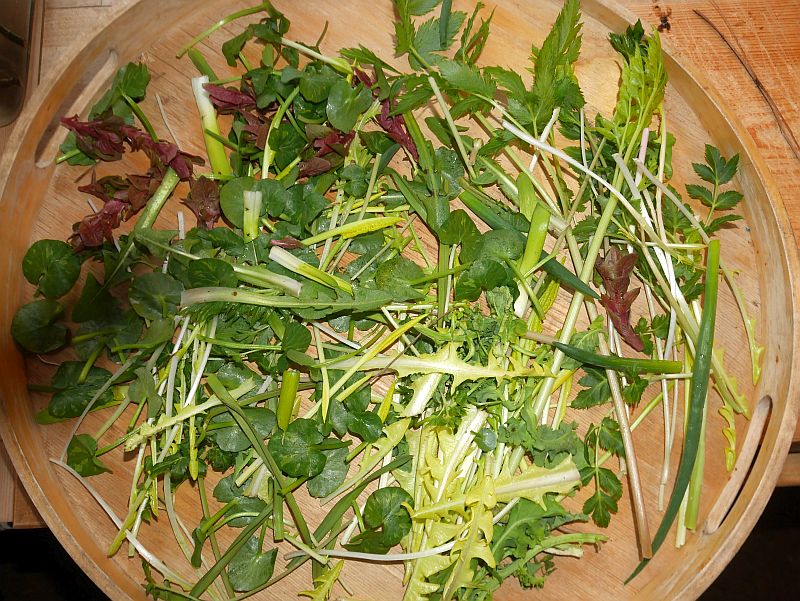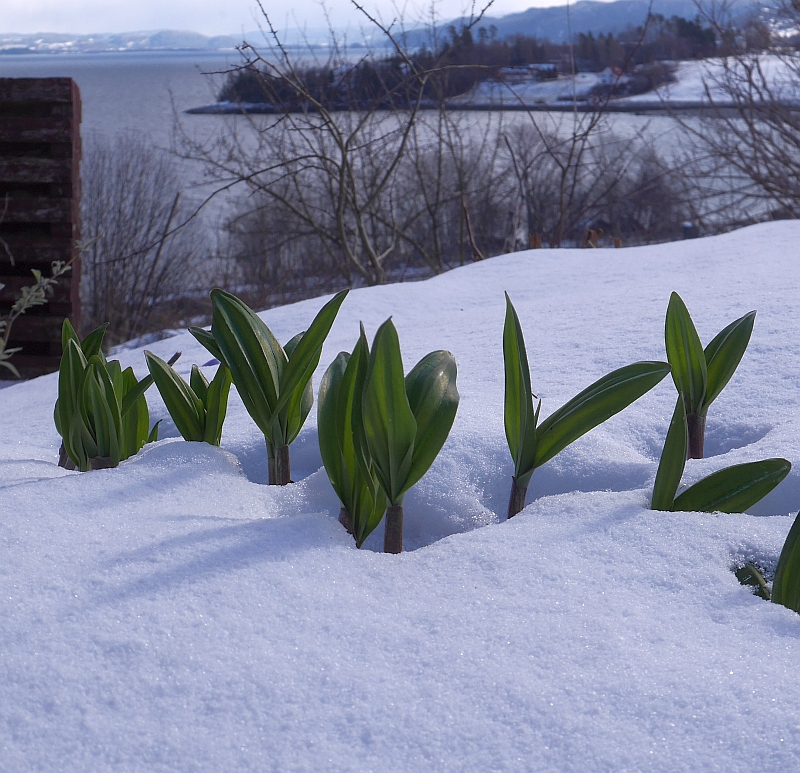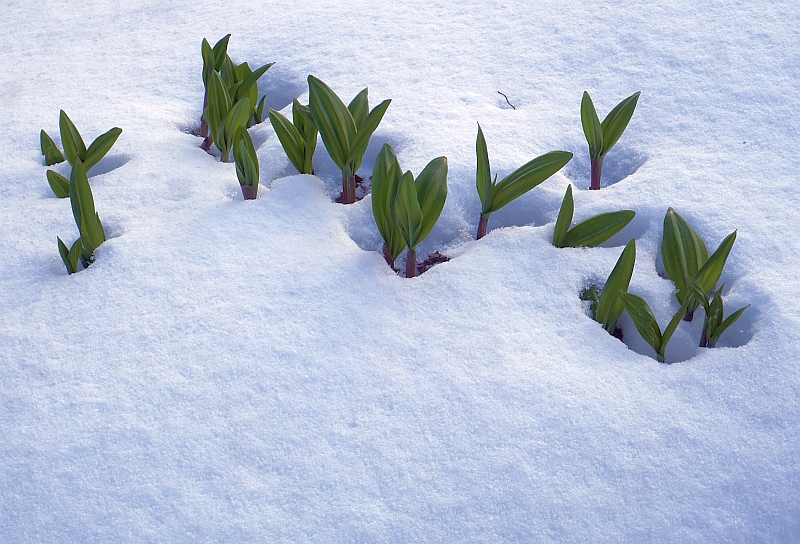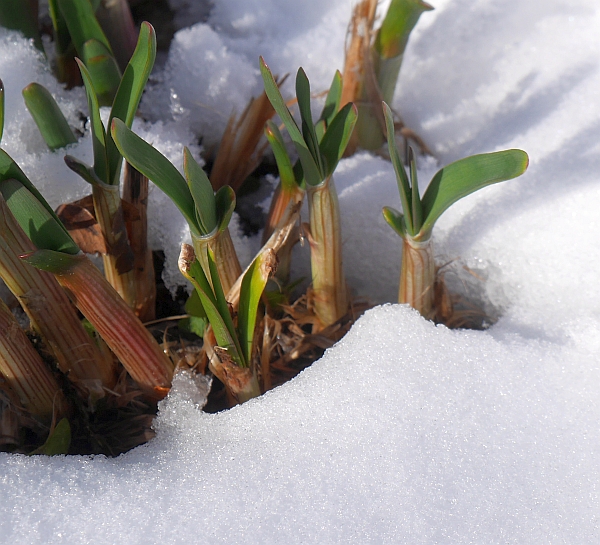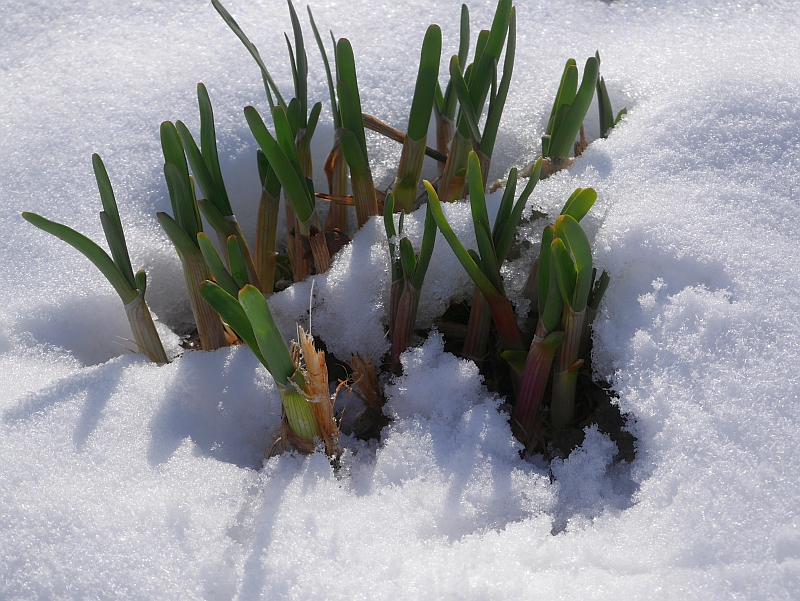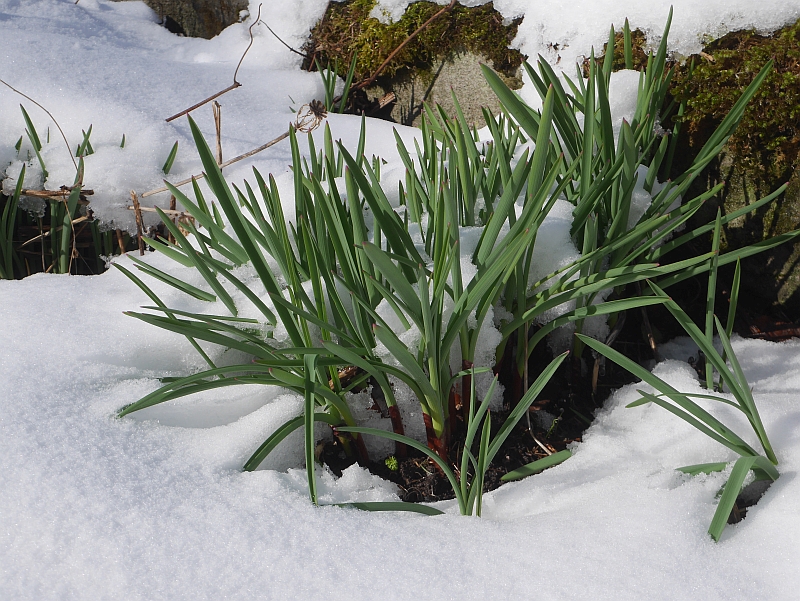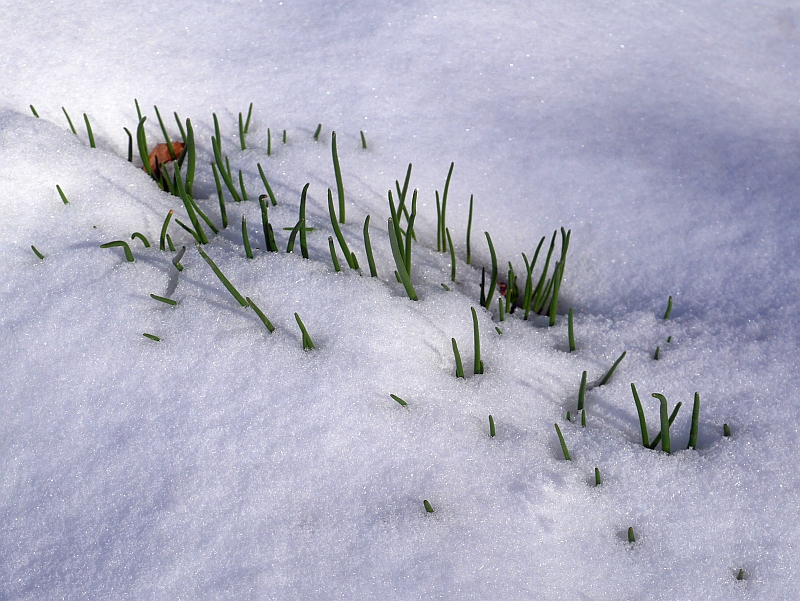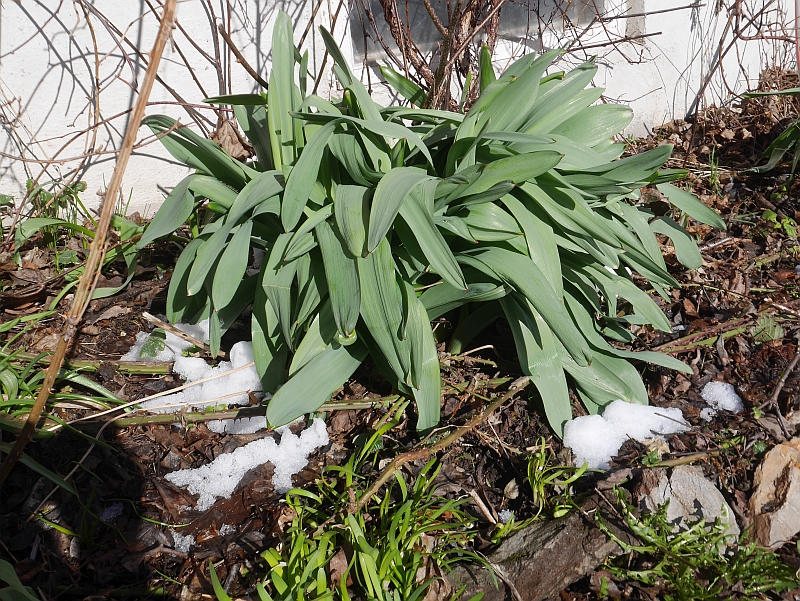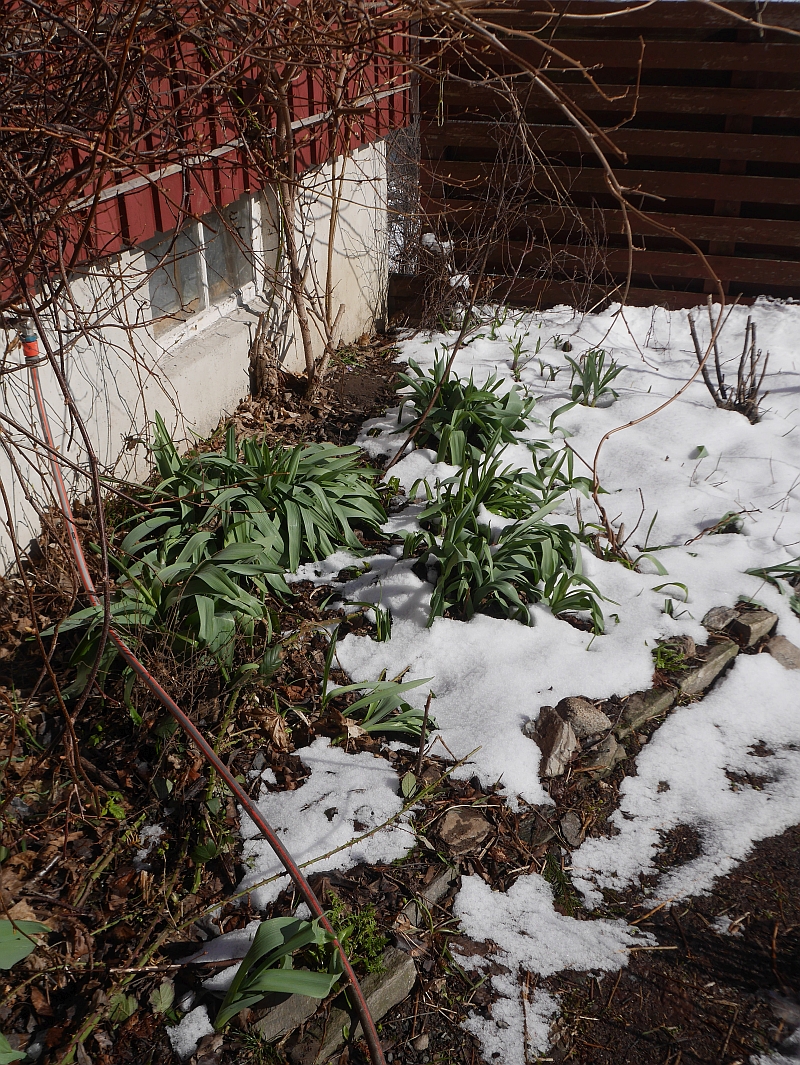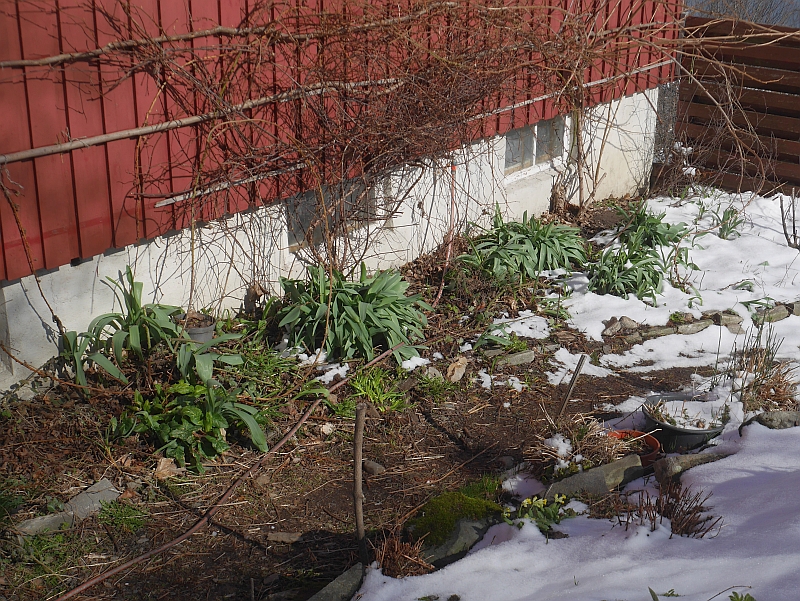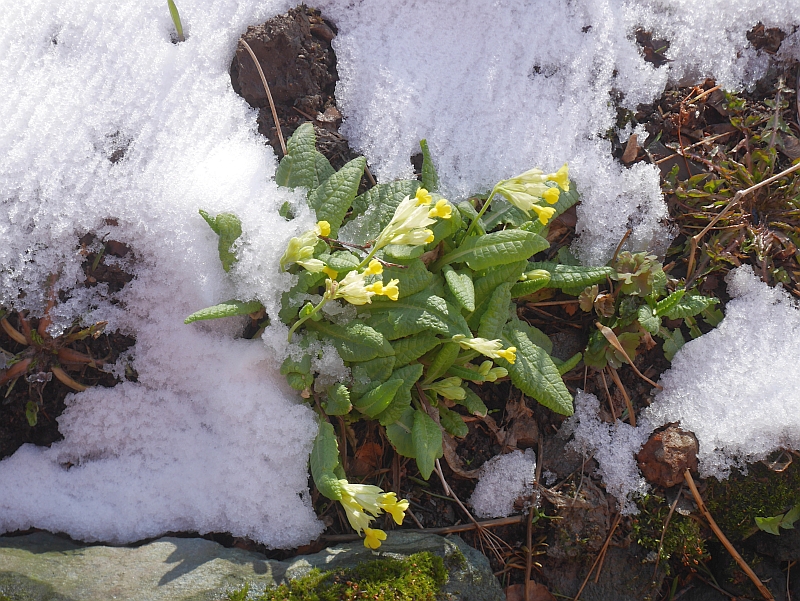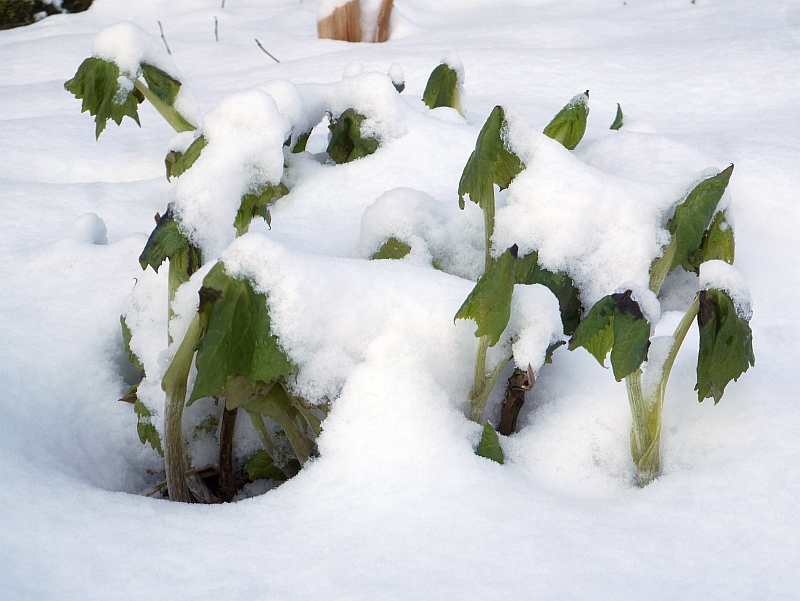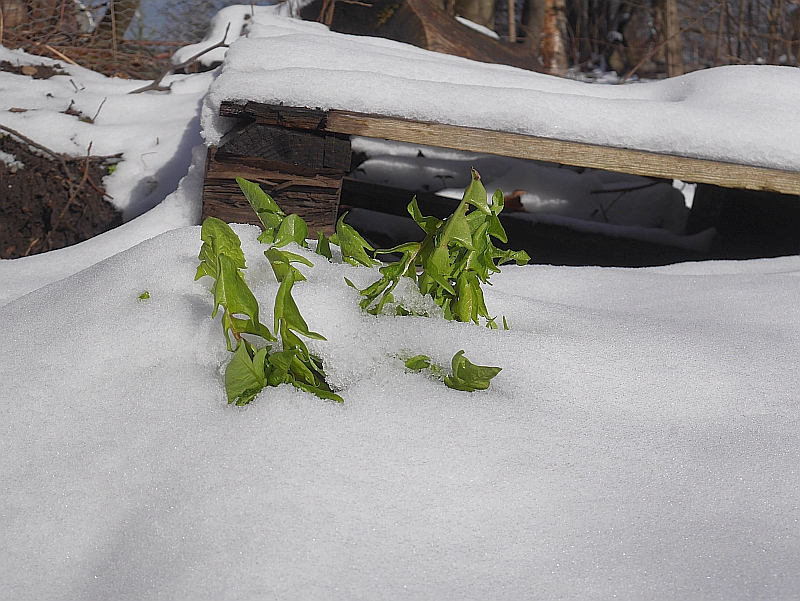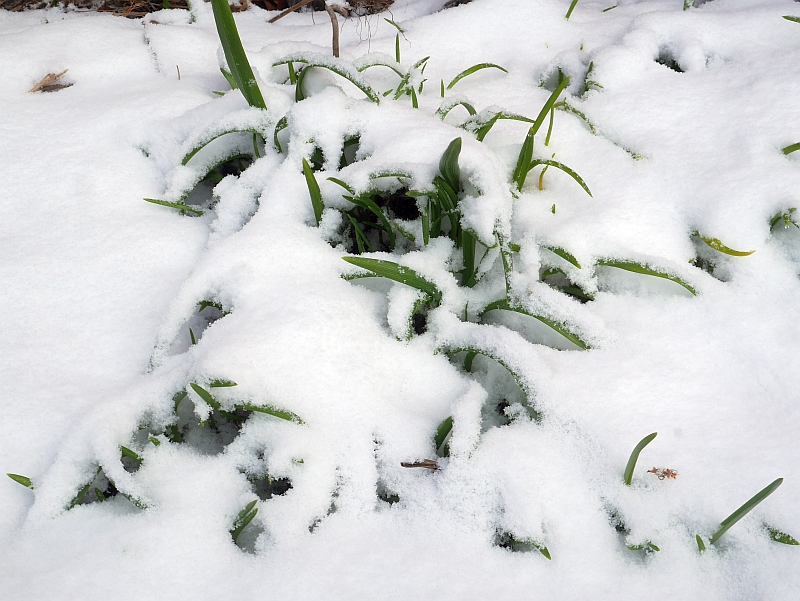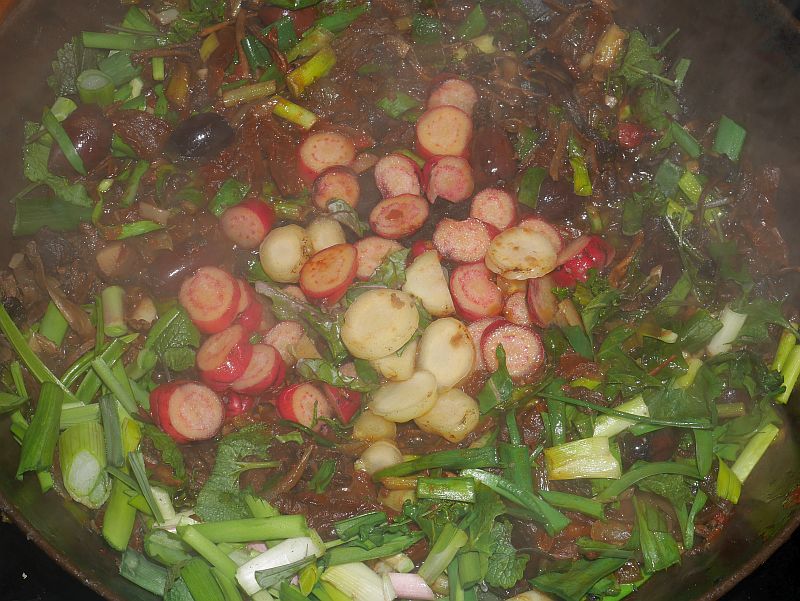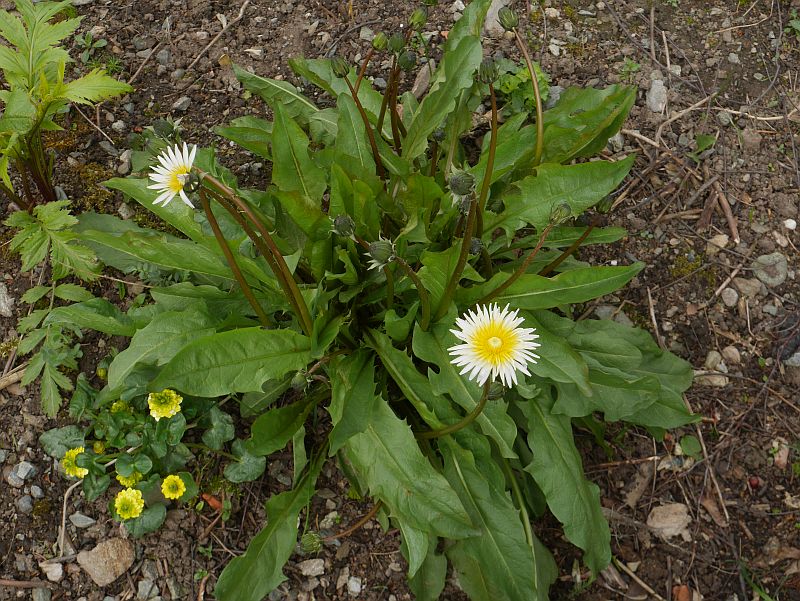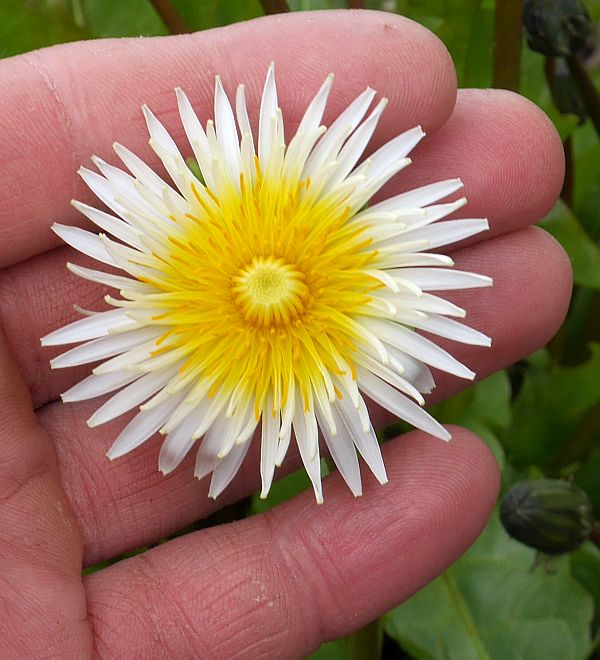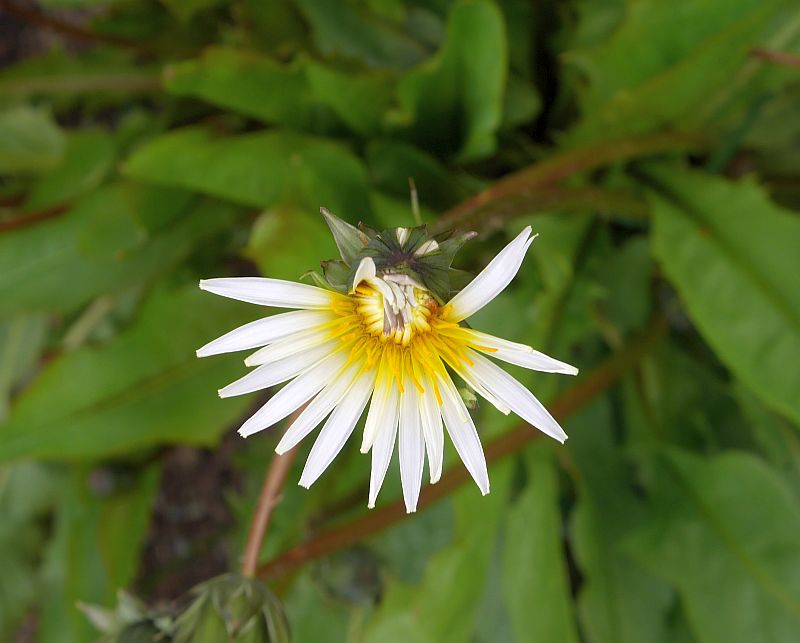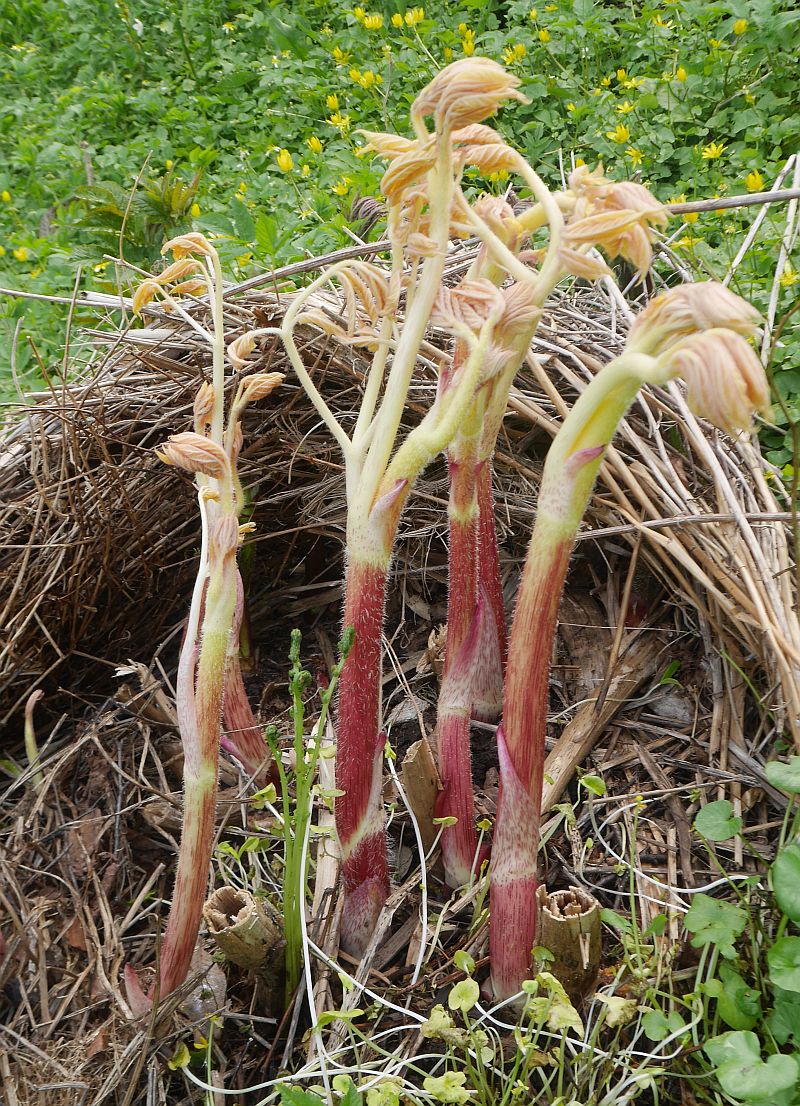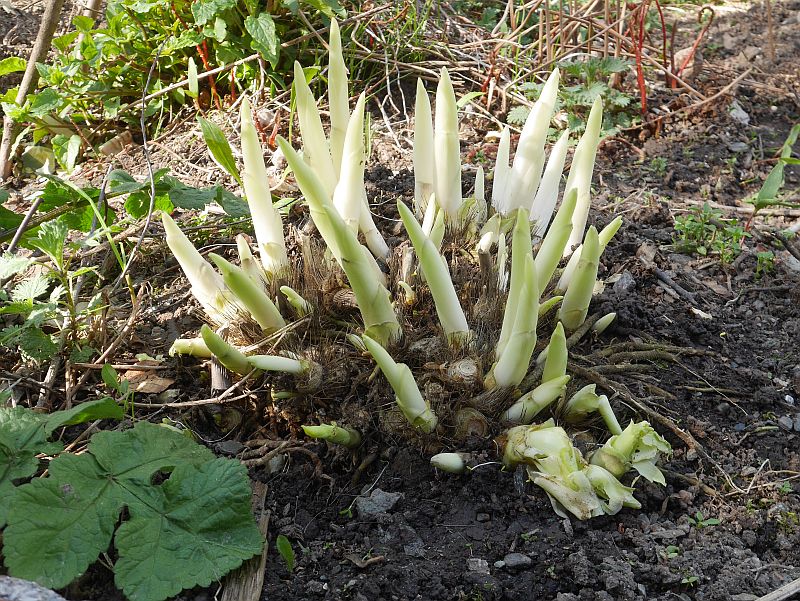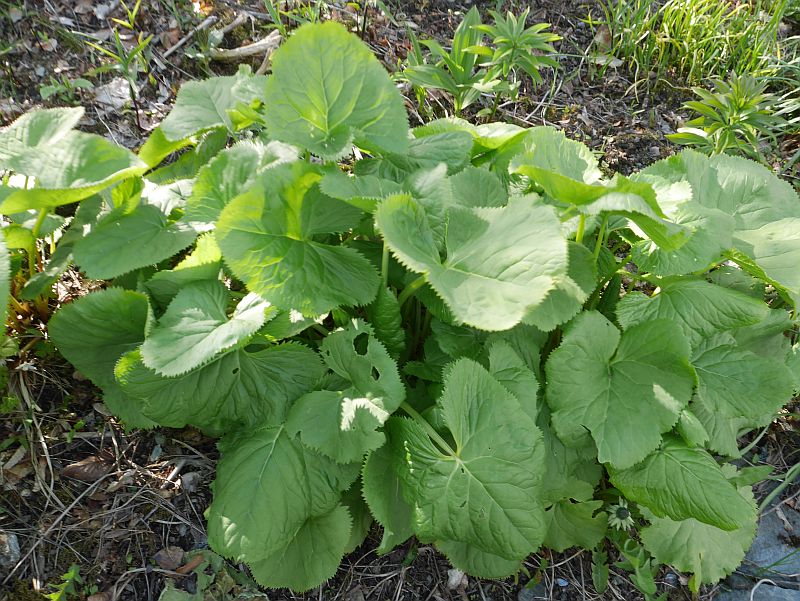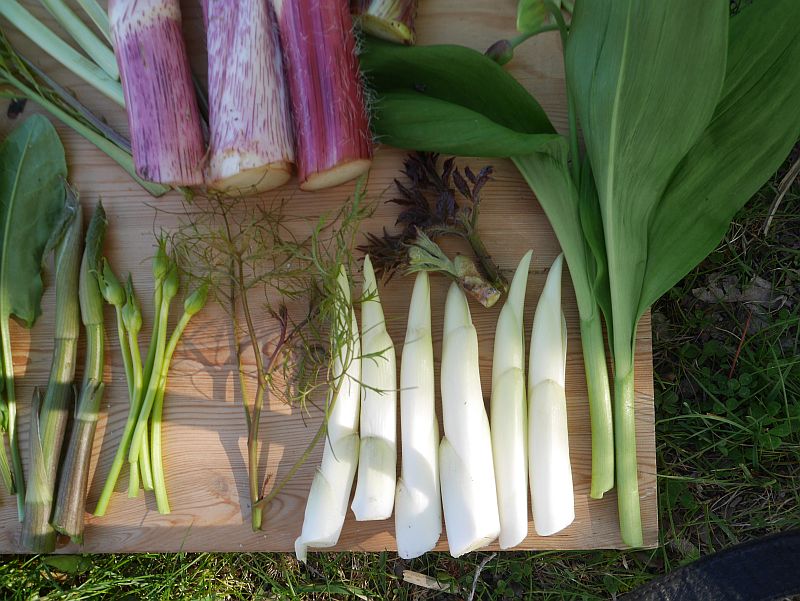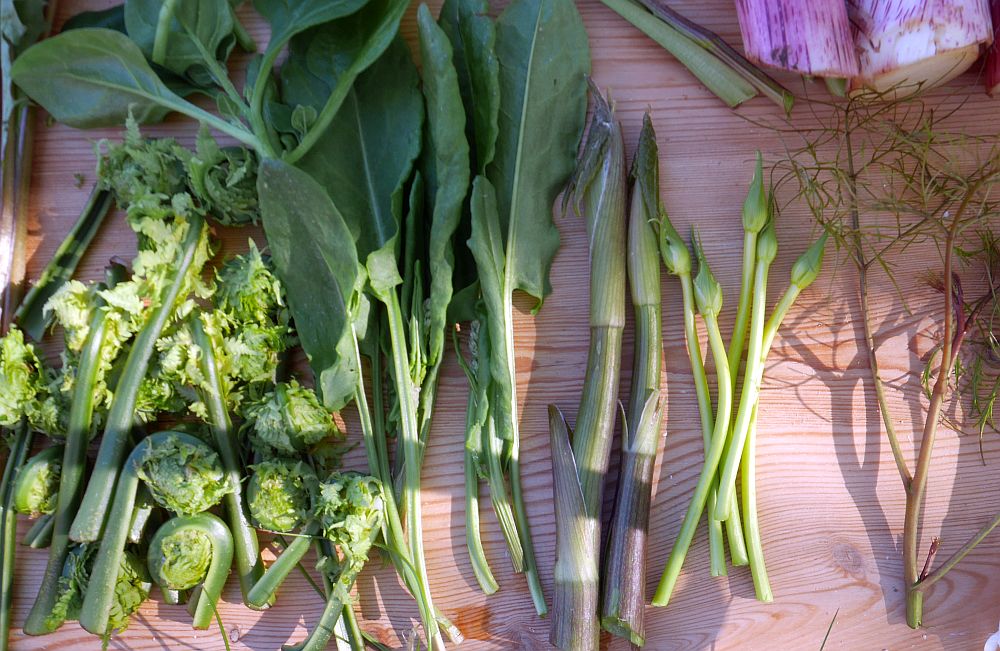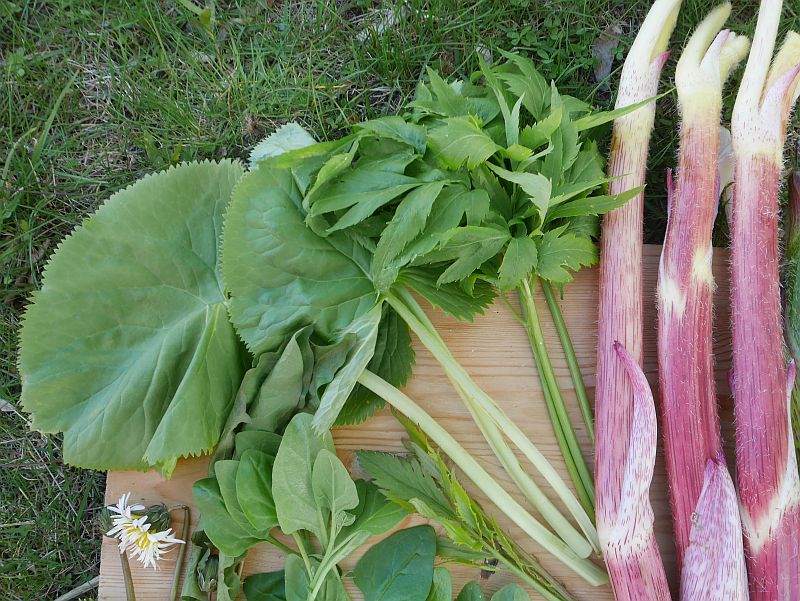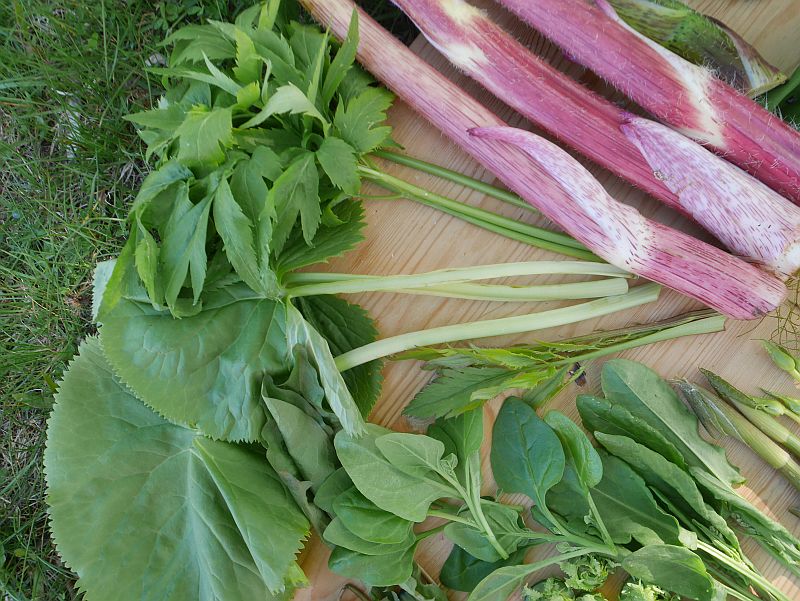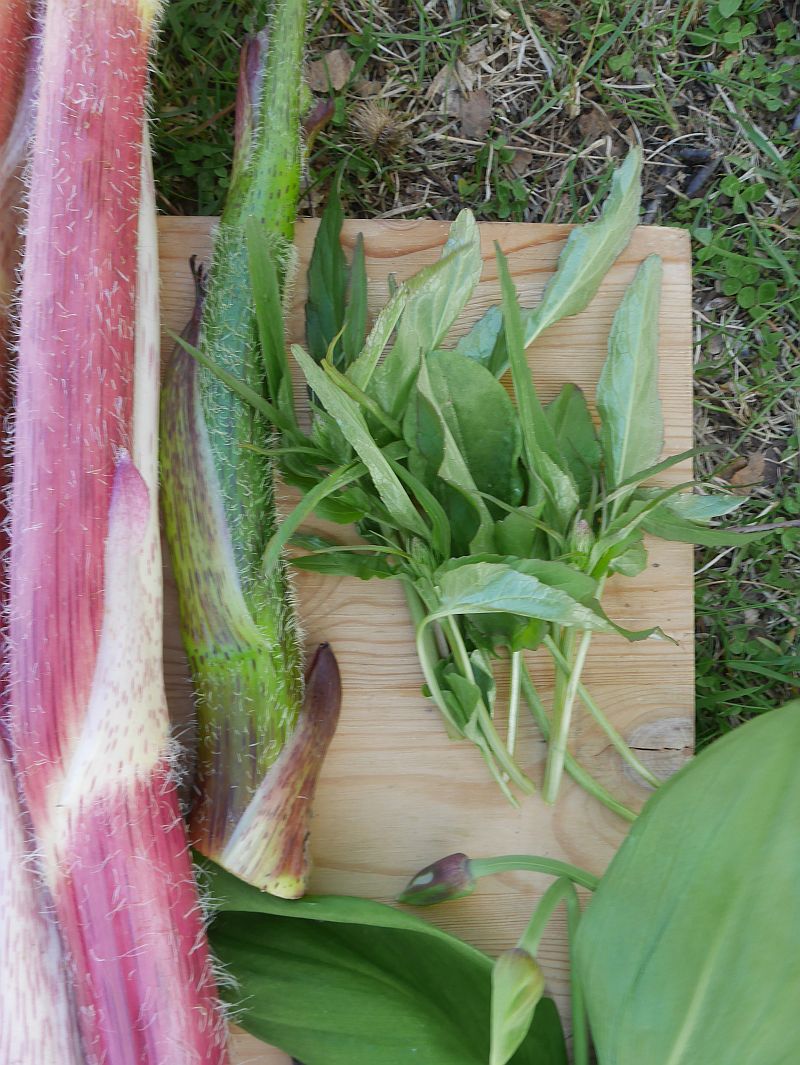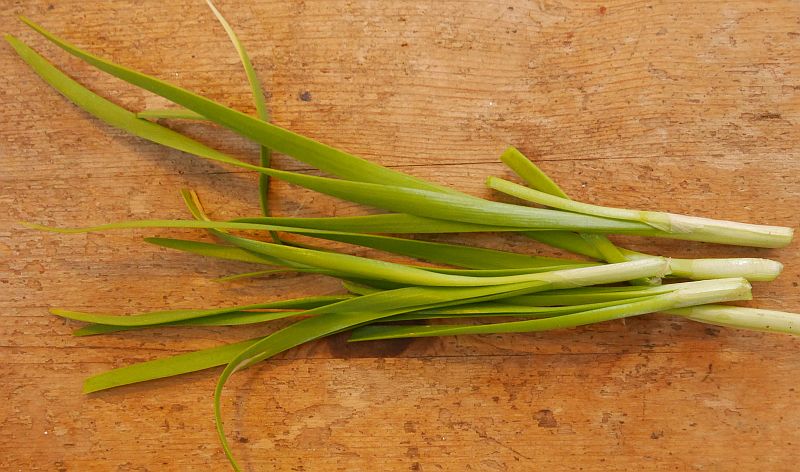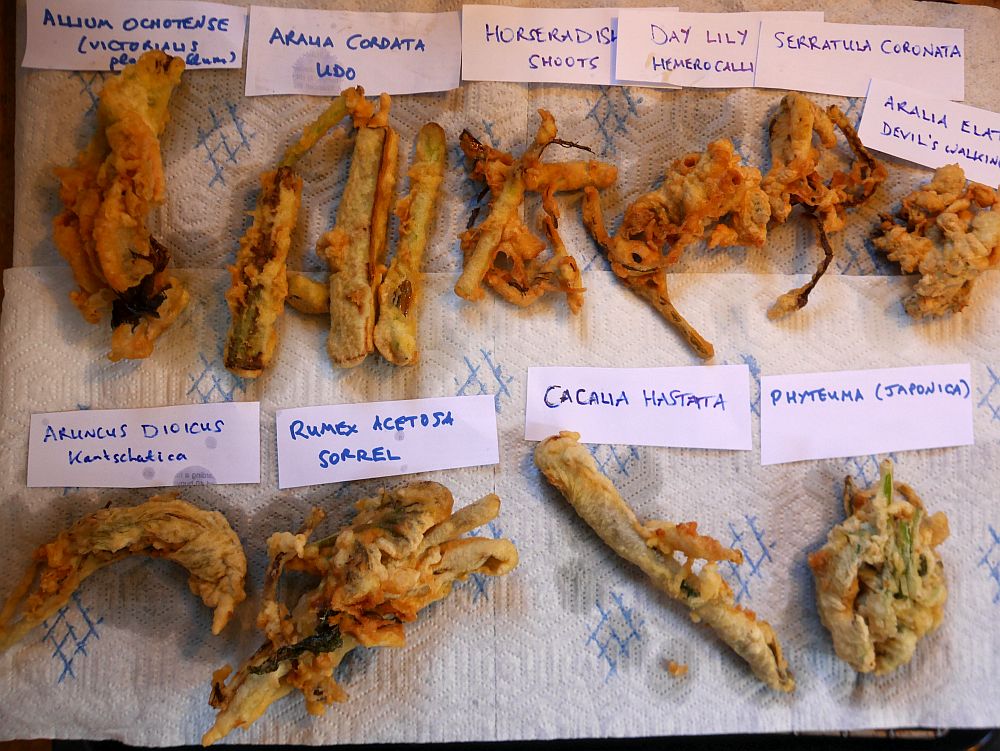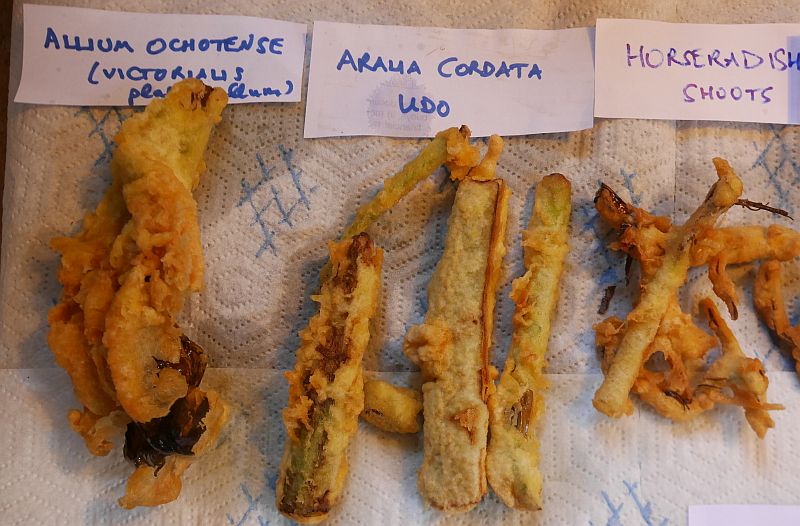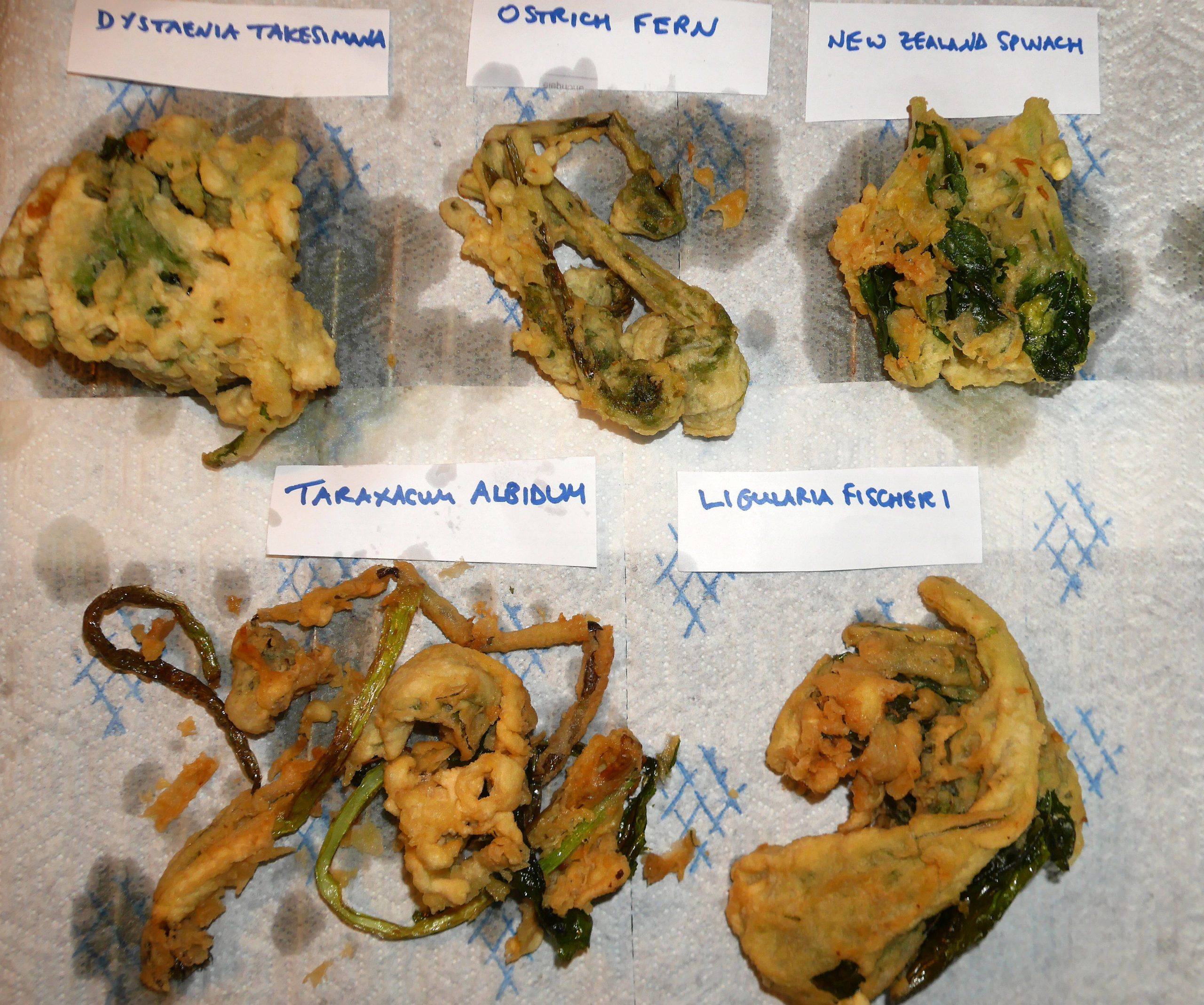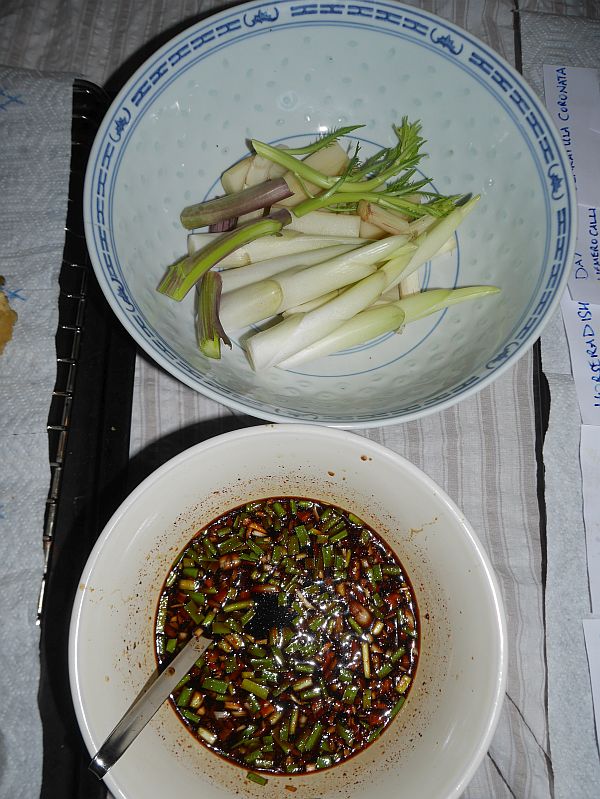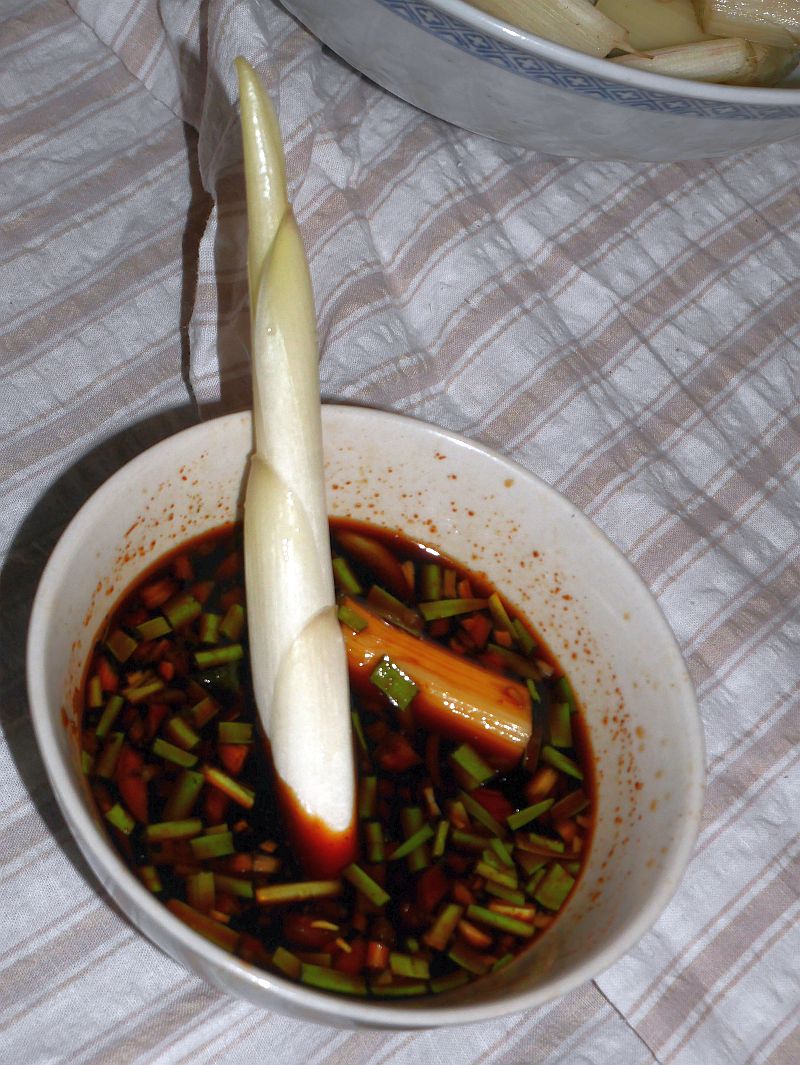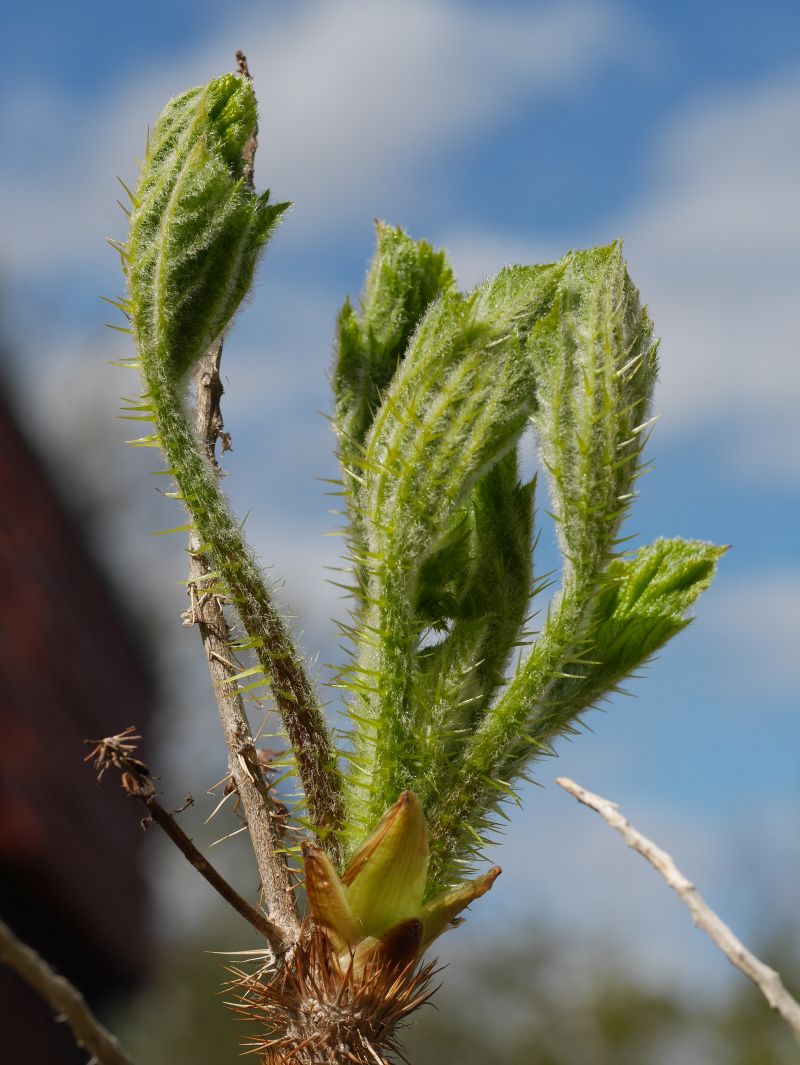The greens that went into last night’s wholegrain spelt quiche are listed below the picture!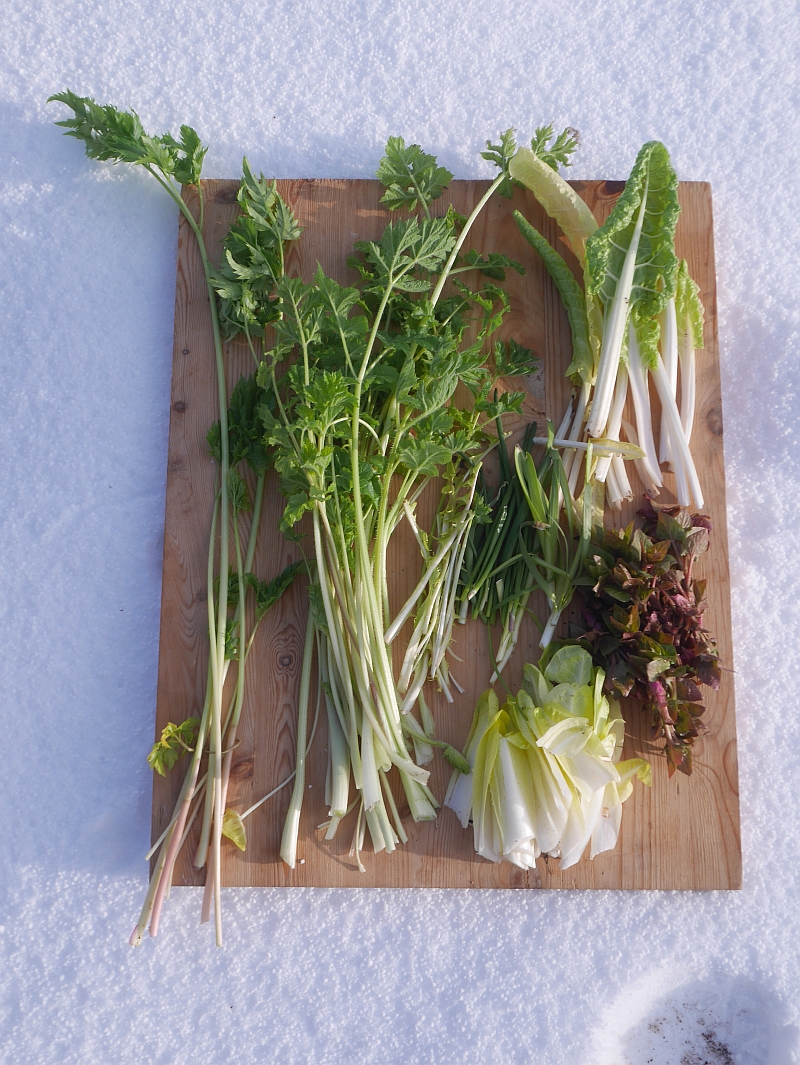 CELLAR: Dystaenia takesimana shoots; Forced hogweed (bjørnekjeks) shoots (Heracleum spp.); Forced Taraxacum (dandelion / løvetann); nederst til høyre: Witloof chicory (sikkori); øverst til høyre: swiss chard (mangold)
CELLAR: Dystaenia takesimana shoots; Forced hogweed (bjørnekjeks) shoots (Heracleum spp.); Forced Taraxacum (dandelion / løvetann); nederst til høyre: Witloof chicory (sikkori); øverst til høyre: swiss chard (mangold)
GARDEN: Various hybrid onions (Allium senescens x nutans) and Hablitzia tamnoides (Caucasian spinach / stjernemelde)
Tag Archives: Dystaenia takesimana
Snow onions


Various Allium species are the hardiest of edible plants either staying green all winter (e.g., Allium cernuum and Allium carinatum) or sprouting very early and able to withstand some frost. With a minimum forecast of -6C tomorrow after a very mild March, it will be interesting to see whether any of these early shooters are damaged. Here are a selection of pictures of Alliums and other early spring shoots in this weeks snow.
Dystaenia heaven
Along with many members of the Apiaceae (carrot family / umbellifers) the flowers of Dystaenia takesimana (Giant Ulleung Celery) are heaven for pollinators like hoverflies (blomsterfluer).
These great edi-ento-mentals thrive both in sunny conditions and in the complete shade of this Buddleja davidii (butterfly bush / sommerfuglbusk).
For more on this great multi-purpose plant, see https://www.edimentals.com/blog/?p=24998
First Garden Forage of 2021
Most of the greens are now finished in the cellar, so time for the first harvest in the garden despite for the fact that it’s been snowing off and on over the last week and air temperatures haven’t risen much over +5C so far this year: 30 different greens plus two varieties of oca made into a diversity green pasta sauce! SO GOOD! Lucky us being able to harvest the best nutrition straight from the garden with little effort. Perennials are best! As usual, the Giant Ulleung Celery (Dystaenia takesimana) has come on furthest of my perennial vegetables! See the list of species used below the pictures.
Species used:
Allium senescens
Allium x proliferum (shoots)
Hablitzia tamnoides
Primula elatior
Allium ursinum
Allium oleraceum
Allium cernuum
Allium nutans
Allium sativum (shoots)
Dystaenia takesimana
Mertensia ciliata
Tragopogon pratensis
Rumex acetosa
Aegopodium podograria
Urtica dioica
Allium paradoxum
Allium victorialis
Barbarea vulgaris
Allium x cornutum
Allium douglasii
Brassica oleracea (perennial kales)*2
Rumex patientia
Allium pskemense
Heracleum sibiricum
Hemerocallis dumortieri
Arabis alpina
Ficaria verna
Angelica archangelica “Vossakvann”
Allium cernuum
Laurus nobilis (inside)
Korean tempura and dipping sauce for perennial vegetables
AROUND THE WORLD IN THE EDIBLE GARDEN; Part 2 – Korea
Inviting you to the second in a series of dinners from Malvik’s Edible Garden where we “forage” from different parts of the world!
We don’t often eat oily food, but now and again its great and this meal was exceptional!
From top left and clockwise:
Ligularia fischeri
Dystaenia takesimana (Giant Ulleung celery, seombadi)
Aralia cordata (udo) (blanched for dipping and green for tempura)
Phyteuma (should have been japonica, but I used nigra; svartvadderot)
Allium victorialis subsp platyphyllum (victory onion; seiersløk)
Aralia elata (devil’s walking stick, fandens spaserstokk)
Hosta “Frances Williams”
Hemerocallis dumortieri (flower shoots) (dayliliy, daglilje)
Parasenecio hastatus (also the first time I ate this one and it was delicious, but I wouldn’t advise eating a lot: see here http://www.edimentals.com/blog/?p=23845)
Matteuccia struthiopteris “Jumbo” (ostrich fern; strutseving)
Taraxacum albidum and to the right of this:
New Zealand spinach and
Serratula coronata (also a first for me; the subspecies insularis is eaten in the Far East)
Oplopanax horridus (North American species substituting Asian species Oplopanax japonicus or Oplopanax elatus)
More information with the pictures!
Quinoa greens
Tonight’s 22 greens from the garden with yacon used in a quinoa stir-fry (with garlic and chili in addition):
Brassica oleracea (perennial kale / flerårig kål)
Hydrophyllum virginianum (waterleaf, indian salad)
Tragopogon pratensis (Jack-go-to-bed-at-noon / geitskjegg)
Angelica spp. (kvann)
Allium carinatum
Allium ursinum (ramsons / ramsløk)
Primula elatior (oxlip / hagenøkleblom)
Hablitzia tamnoides (Caucasian spinach / stjernemelde)
Carum carvi (caraway / karve)
Myrrhis odorata (sweet cicely / spansk kjørvel)
Polymnia edulis (yacon)
Urtica dioica ( stinging nettle / brennesle)
Campanula latifolia (giant bellflower / storklokke)
Ficaria verna (lesser celandine / vårkål)
Rumex acetosa (sorrel / engsyre)
Dystaenia takesimana (giant Ulleung celery)
Hemerocallis spp. (day lily / daglilje)
Taraxacum spp. (dandelion / løvetann)
Rheum ribes
Armoracia rusticana (horseradish / pepperrot)
Allium nutans
Aegopodium podograria (ground elder / skvallerkål)

An alternative spring harvest
Somebody asked me the other day if I use floating mulch (fiberduk / agryl) to be able to harvest all these greens so early. No, no and again no….this is one of the biggest benefits of perennial vegetables….it is totally natural, no microplastics are released into the environment, no oil is needed to plough the fields, significantly less migrant labour is needed and little or no fertiliser and water is needed, it is almost totally free once established and can yield year after year! So, whilst large areas of farmland in the northern hemisphere are being covered by plastic mulches to bring on annual crops for the market earlier, I’d just like to point out that there’s an alternative better way!
So, here are the plants that I harvested for yesterday’s delicious green pasta sauce:
Armoracia rusticana shoots (horseradish / pepperrot)
Myrrhis odorata (sweet cicely / spansk kjørvel)
Houttuynia cordata “Chinese Market” (shoots and rhizomes from the cellar; this cultivar is significantly larger than other Houttuynia I’ve grown) (Fish herb, Himalayan water creeper)
Allium senescens x nutans (hybrid Siberian onions)
Laurus nobilis (bay / laurbær)
Brassica oleracea (perennial kales)
Crambe maritima (sea kale / strandkål)
Taraxacum officinale (dandelion / løvetann)
Allium x proliferum (walking onion / luftløk)
Hablitzia tamnoides (Caucasian spinach / stjernemelde)
Dystaenia takesimana (giant Ulleung celery, seombadi)
Oenanthe javanica (seri)
Polymnia edulis (yacon) (second picture)
plus garlic and chili
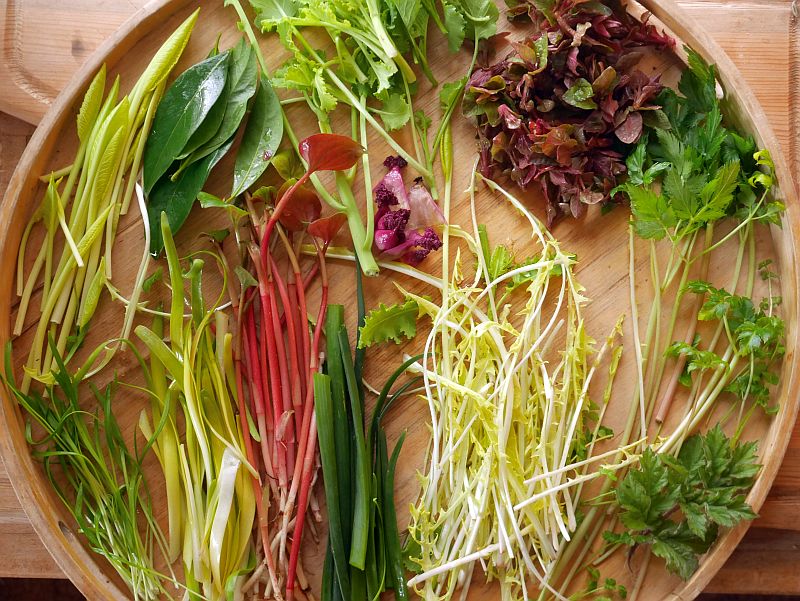
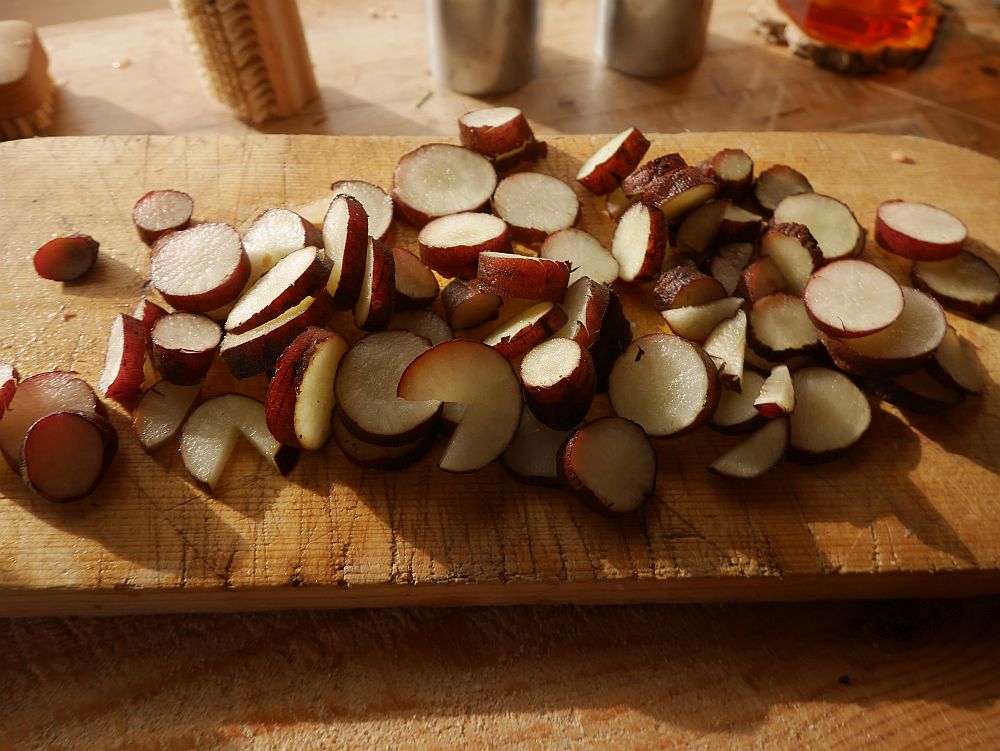
27th March Veggies from the garden
Tonight we made a quiche (eggepai) with these vegetables:
Allium nutans (Siberian nodding onion)
Allium cernuum (nodding onion / prærieløk)
Dystaenia takesimana (Giant Ulleung Celery)
Brassica oleracea (Perennial kale / flerårige kål)
Allium paradoxum
Allium oleraceum
Alliaria petiolata (hedge garlic / løkurt)
Angelica archangelica (Voss Angelica / Vossakvann)
Myrrhis odorata (Sweet cicely / spansk kjørvel)
Tragopogon pratensis shoots ( Jack-go-to-bed-at-noon / geitskjegg)
Carum carvi (caraway / karve)
Aegopodium podograria (ground elder / skvallerkål)
Hablitzia tamnoides (Caucasian spinach / stjernemelde)
Taraxacum officinale (dandelion / løvetann)
Rumex acetosa (sorrel / engsyre)
Smyrnium olusatrum (Alexanders / sorte løpstikke)
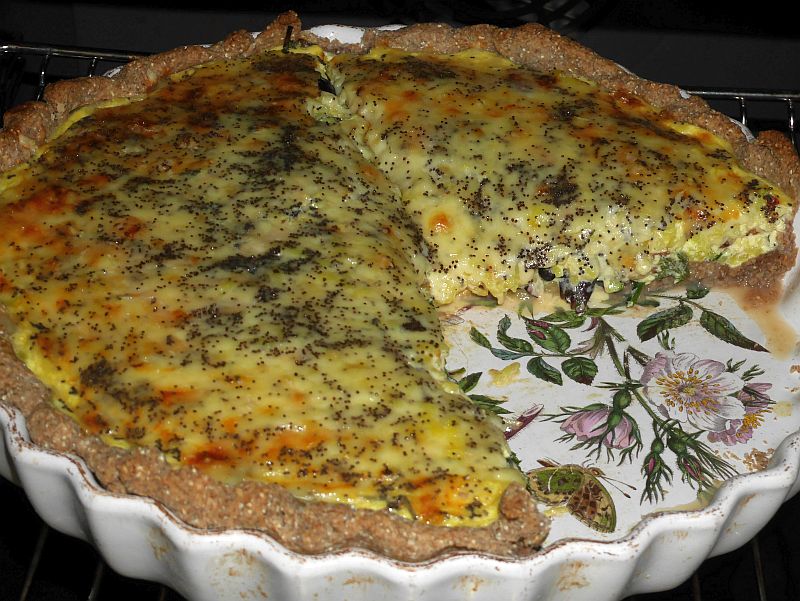
Giant Ulleung Celery
In my world, plants that are both perennial, edible, ornamental and popular with pollinating insects are the most valuable (I term this class of plants edi-ento-mentals) and the Giant Ulleung Celery, Dystaenia takesimana, ticks all 3 boxes! That it can provide winter greens at a time of year when little else is available is its biggest advantage as an edible plant! This plant has been a closely guarded secret amongst a selected few for many years, but is now poised for the big(ger) time! The fact that I’ve written the article below about this plant is thanks to one man, plant breeder Professor Elwyn Meader (1910-1996) who collected seed on its small home island of Ulleung-do in the East Sea between the Korean peninsular and Japan in 1953! Without his generosity and enthusiasm 30 or so years ago to share seeds, we wouldn’t know about one of the potentially most useful permaculture plants! Please download the article below and seek out plants and seed!
The photo below of a flowering Giant Ulleung Celery at Eric Toensmeier’s home Paradise Lot in Holyoke, Massachusetts is courtesy of Jonathan Bates, who’s in the picture too.
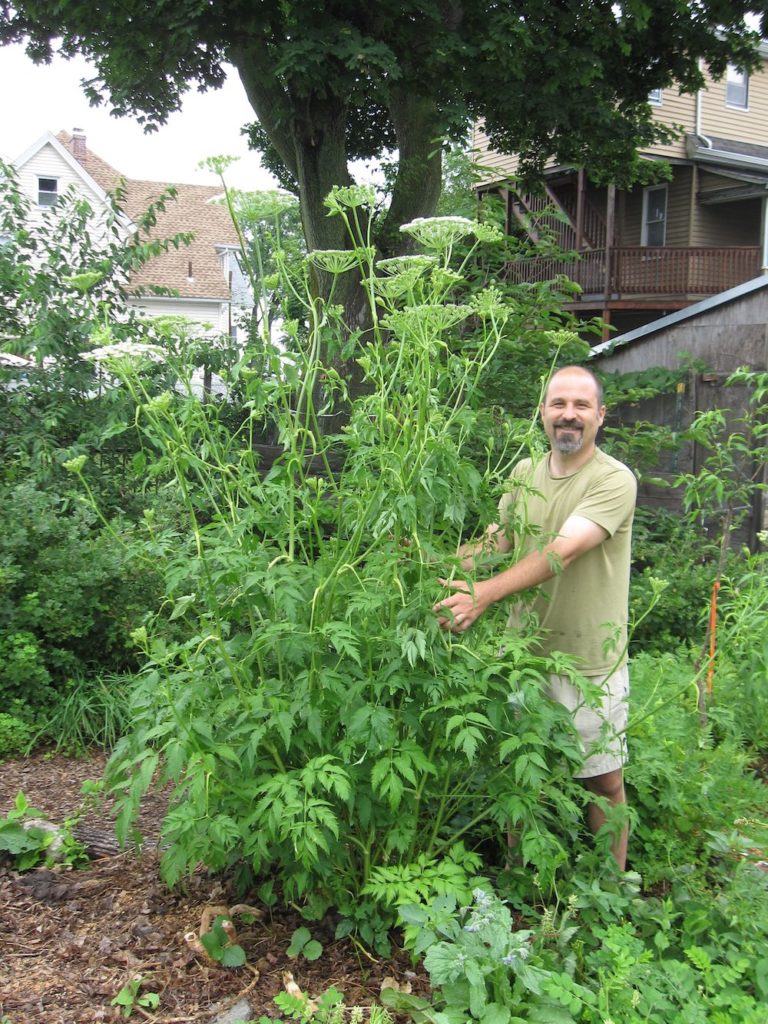
Catch of the day!
Yesterday’s harvest mostly from the garden (blanched dandelions and horseradish from the cellar):
Ground elder (skvallerkål)
Lesser celandine (vårkål)
Perennial kale (flerårige kål)
Seombadi (Dystaenia takesimana)
Dandelion (løvetann)
Allium x proliferum (walking onion / topset onions; luftløk)
Allium scorodoprasum (rocambole; bendelløk)
Allium nutans
Horseradish (pepperrot)
Ground elder (skvallerkål)
Lesser celandine (vårkål)
Perennial kale (flerårige kål)
Seombadi (Dystaenia takesimana)
Dandelion (løvetann)
Allium x proliferum (walking onion / topset onions; luftløk)
Allium scorodoprasum (rocambole; bendelløk)
Allium nutans (pepperrot)
Hablitzia tamnoides (stjernemelde)